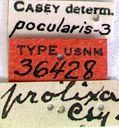Prionus
Prionus
Classification
- Phylum: Arthropoda
- Subphylum: Hexapoda
- Class: Insecta
- Order: Coleoptera
- Suborder: Polyphaga
- Superfamily: Chrysomeloidea
- Family: Cerambycidae
- Subfamily: Prioninae
- Tribe: Prionini
- Genus: Prionus
Pronunciation
How to pronounce Prionus: /ˈpraɪoʊnəs/
These audio files are automatically generated. While they are not always 100% accurate, they are a good starting point.
Images






Summary
Prionus is a genus of long-horned beetles found in the subfamily Prioninae, notable for their large size and characteristic long antennae with toothed segments. They are distributed widely in the Holarctic and are primarily nocturnal.
Physical Characteristics
Members of the genus Prionus are large beetles measuring 25–70 mm in length and are usually brown or black. They have twelve or more strongly toothed or evanescent antennomeres on their large antennae.
Identification Tips
Sexual dimorphism is evident, with males typically having distinctly poriferous antennomeres, while females have less pronounced structures. Identification can be assisted by examining the number of antennomeres, which varies by subgenus.
Habitat
Larvae feed on rotting wood or roots, indicating a preference for wooded areas where decaying plant matter is abundant.
Distribution
Prionus is primarily holarctic in distribution, with species found across Europe, Asia, and North America. In North America, they range from southern Canada to Mexico, with one species present in the Dominican Republic.
Diet
Larvae of Prionus feed on rotting wood or roots.
Life Cycle
The adults are nocturnal and attracted to light; specific details about their life cycle are not provided.
Ecosystem Role
As decomposers, the larvae play a significant role in breaking down rotting wood and recycling nutrients in their ecosystem.
Similar Taxa
- Cerambycidae
- Long-horned beetles
Tags
- Coleoptera
- Beetles
- Prioninae
- Ecosystem
- Conservation